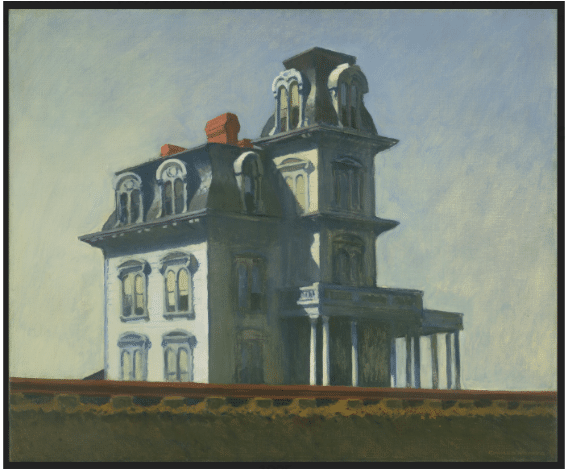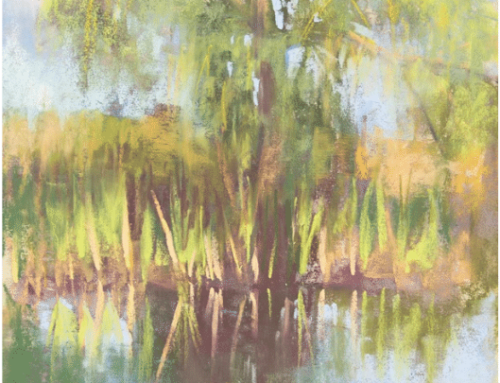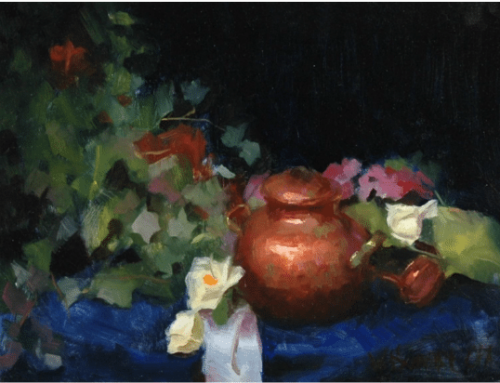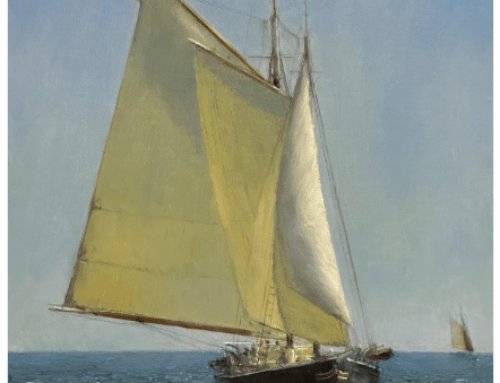Poetry and painting share some DNA. To feel what’s in a painting, you must “read” it first – which means you must look closely with an emotional and imaginative eye at what the artist gives you.
For example, it’s apparent from the get-go that Edward Hopper’s “The House by the Railroad” of 1925 is not just an architectural rendering of a house. To see and feel what else it might be, however, you must follow some subtle visual cues.
Consider the light – Hopper uses strong, unflattering sunlight with a blank, nowhere-to-hide quality that bleaches out the house’s exterior – the same way it strips his anonymous figures to stark, unidealized essentials.
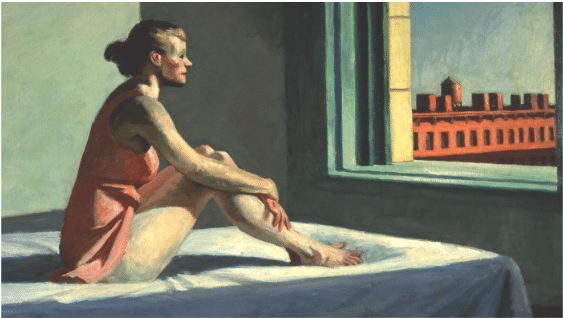
Edward Hopper, Morning Sun, 1952
Figures, however, are conspicuously absent from The House by the Railroad. The building appears isolated, perhaps abandoned. In this painting, as in many a Hopper, the sky is unreadable – it’s as blank as everything else, a shifting warm-cool blue-yellow-green. The portico columns, the way their cold bright light sets them off from the shadows, have a “picked clean” quality, like bones.
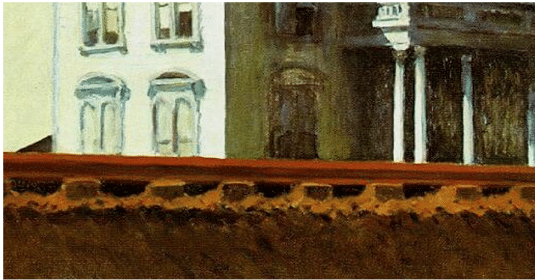
Detail, Edward Hopper, The House by the Railroad, 1925
As you further study The House by the Railroad, you discover something odd about the foreground. Hopper has swapped out the ground for a closer-up train track that visually eclipses the bottom part of the house, cutting it off from its foundation. Why?
One answer, perhaps, is that this somewhat awkward and seemingly odd compositional choice functions expressively, contributing to the cut-off isolation of the place and the sense that the house and any life once lived in it has been “passed by.” Do trains even pass by here anymore though? The railroad tracks seem to have gone to rust.
Did Hopper deliberately think all of this through before he started? Almost certainly not. More likely, he just looked, felt what he felt, and then painted that. However, distinct choices have been made. He liked to quote the German writer Goethe when describing his process: “the reproduction of the world that surrounds me by means of the world that is in me.”
Being a good painter, Hopper seized on the elements of what he saw that resonated with him “for whatever reason.” To do this, an artist enters into a sort of mental dialogue with the subject, painting what it “says” in a way that he or she and others can see and understand.
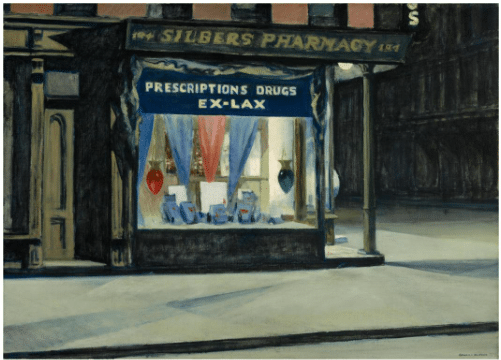
Edward Hopper, Drug Store 1927
Poet Edward Hirsch has written a poem about “House by the Railroad” that explores the artistic process in general through a series of imaginative stories, about the house, the painter, and the psychological dance between the two.
Edward Hopper and the House by the Railroad (1925)
By Edward Hirsch
Out here in the exact middle of the day,
This strange, gawky house has the expression
Of someone being stared at, someone holding
His breath underwater, hushed and expectant;
This house is ashamed of itself, ashamed
Of its fantastic mansard rooftop
And its pseudo-Gothic porch, ashamed of
Its shoulders and large, awkward hands.
But the man behind the easel is relentless;
He is as brutal as sunlight, and believes
The house must have done something horrible
To the people who once lived here
Because now it is so desperately empty,
It must have done something to the sky
Because the sky, too, is utterly vacant
And devoid of meaning. There are no
Trees or shrubs anywhere – the house
Must have done something against the earth.
All that is present is a single pair of tracks
Straightening into the distance. No trains pass.
Now the stranger* (*Hopper, that is, from the house’s perspective) returns to this place daily
Until the house begins to suspect
That the man, too, is desolate, desolate
And somehow ashamed. Soon the house starts
To stare frankly at the man. And somehow
The empty white canvas takes on
The expression of someone who is unnerved,
Someone holding his breath underwater.
And then one day the man simply disappears.
He is a late afternoon shadow moving
Across the tracks, making its way
Through the vast, darkening fields.
The man will paint other abandoned mansions,
And faded cafeteria windows, and poorly lettered
Storefronts on the edges of small towns.
Always they will have this same expression,
The utterly naked look of someone
Being stared at, someone American and gawky,
Someone who is about to be left alone
Again, and can no longer stand it.
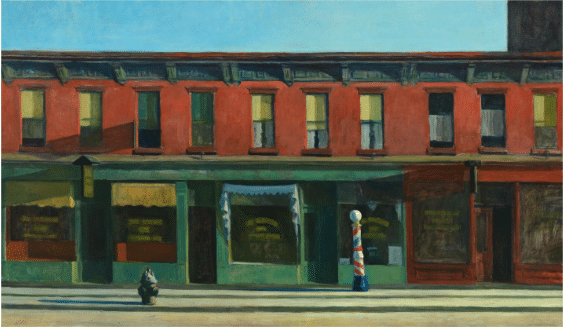
Edward Hopper, Early Sunday Morning, oil on canvas, 35 3/16 × 60 1/4in.
1930
Walking on Sunshine: Bird Paintings with Big Shoes to Fill
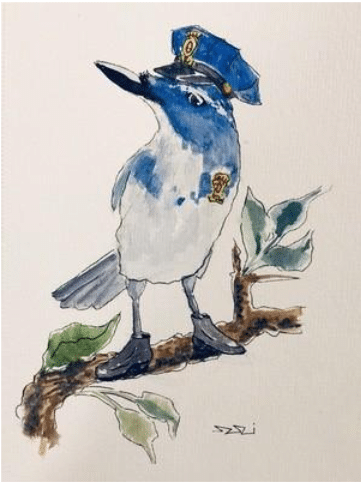
Suzi Long, Stellar Jay Cop, watercolor and permanent ink on paper
A three-time cancer survivor, artist Suzi Long’s motto is Only those who risk going too far know how far it is possible to go.
“You could say I went rogue when I moved into the 21-foot RV in 2019,” says the artist, who makes and sells her work in Northern California. “I had a six-month COVID trip around the west, meeting almost no one… But I captured lots of barn photos to paint!”
It isn’t barns right now but birds that have been one of her most successful projects to date. Her “Feathered Feetures” series of birds sporting fancy footwear successfully debuted at Willits Center for the arts in 2021. She currently shows at John Hanes Gallery in Mendocino and at Sportsman’s Park Gallery in Fort Bragg. In addition, Suzi sells cards, matted prints and small original watercolors at local art and craft fairs and is ramping up an online sales platform.
In further a whimsical touch, each of the artist’s images is accompanied by a short writeup online. “Night Owl” for example, besides rocking the on-point pink slip-ons, offers the following monologue in rhyme:
“The sun comes up, it’s time for bed, so I put on my slippers.
I’d rather have the slip-on kind than ones that might have zippers.
Warm and fuzzy soft and pink, they’re quite stunning, don’t you think?”
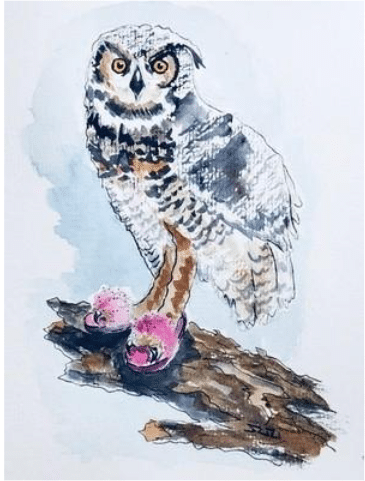
Suzi Long, Night Owl, watercolor and permanent ink on paper
Her 21’ 2002 Winnebago Vista serves as a good studio, she says,
But if converting an RV into a live-in studio (Monet’s Bateau-atelier << https://en.wikipedia.org/wiki/The_Studio_Boat_(Le_Bateau-atelier) << comes to mind) is going rogue, what’s it called when you operate your own pastel gallery in an 1870’s water tower? Because Suzi’s done that too.
Suzi ran her water tower gallery in Mendocino from 2006 to 2018. The structure just caught her eye, and when she discovered it had a “For Rent” sign on it, she jumped in. Running a gallery is never easy, but she ended up making it work and teaching during the off-season, sticking with it for over a decade.
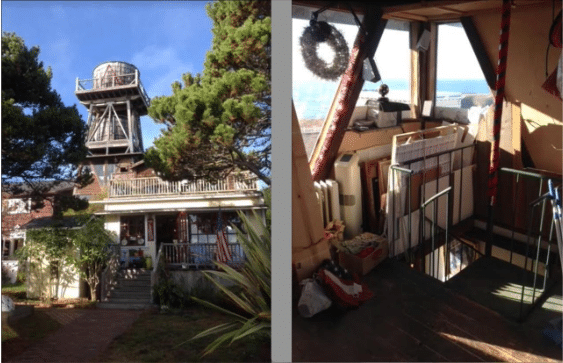
Suzi Long’s water tower studio in Mendocino, CA
For now, Suzi’s parked the RV. “I have been doing a lot of housesitting locally because the gas prices are so high,” she says. “It makes no sense to go on the road right now.”
Still, one gets the impression that whatever life brings, there’s a good chance she’ll be ready to roll with it.
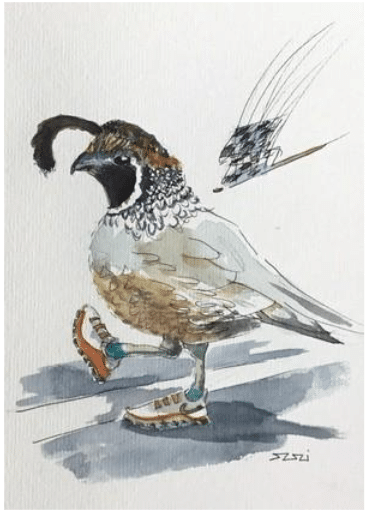
Quail in Trainers
“I got me some running shoes with traction on the sole.
They help me to run really fast, though I don’t have a goal!
I can win most any race against another bird …
but I just raced two hummingbirds and dang! I came in third!

